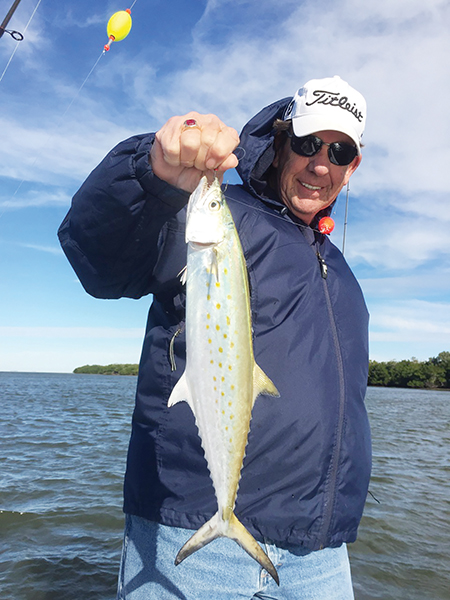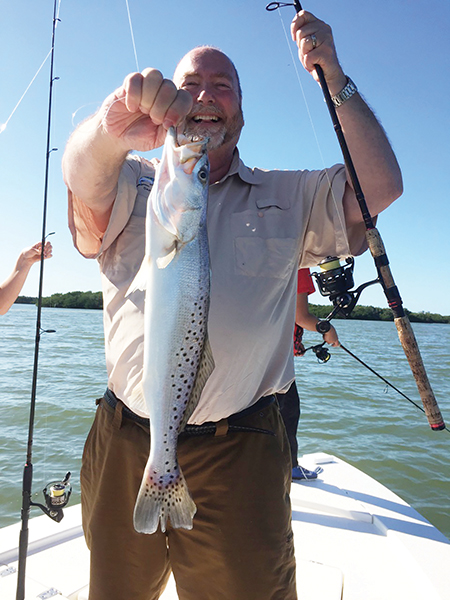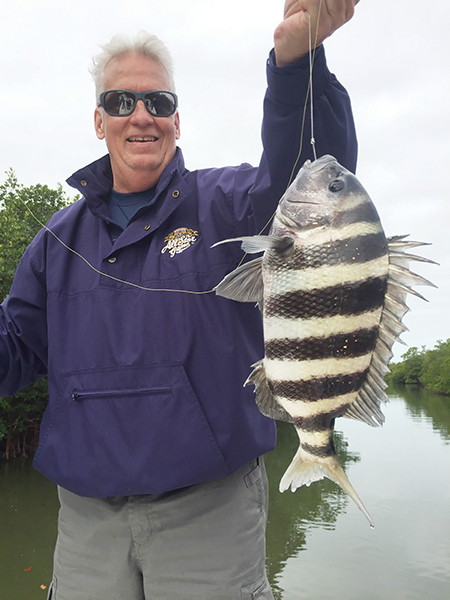Capt. Terry Fisher
I am happy to see February come around, as it basically ends the transition month of species and all winter inhabitants are surely in good numbers and sizes in our waters. Water temperatures control the species and their activities. This is definitely ‘Sheepshead’ month. Rumored to be difficult to catch and clean, they are also fun to catch and great to eat. They will be found throughout Pine Island Sound along the seawalls, piles, mangroves and oyster beds. Look for them when and where there is current flow for better results. Like most all other inshore species, fish on either the incoming or an outgoing tide. The big ones are in from the depths of the gulf to spawn and eat, while offering some of the best action that light tackle will provide.
Sheepshead are not difficult to catch when the ‘bite is on’. Just like all other species of fish, they do not bite non-stop, but have feeding times when they are very aggressive. When these fish go into their feeding mode, they are quite easy to catch. Anglers targeting these fish need only to realize that it is during the feeding phase, that they basically hook themselves and become easier to catch. Like other species, they have a tendency to ‘school’. When the small fish eat, the larger ones are on ‘break’. However, when the larger ones decide to feed, the small fish seem to disappear, as if to make room for them.
Recognizing a sheepshead bite from another species is key to understanding how and when to set the hook (or when to move to another location in search of them). Hard hits and redundant ‘nibbles’ are small mangrove snappers. When mangrove snappers are biting, odds are the sheepshead are not eating or are not in that location. Light ‘tugs’ or gentle ‘pulls’ are sheepshead. Often they will pick up the bait and swim away to the left or right of the initial presentation. Any of these events triggers the time to remove some of the slack in the line and set the hook.
My bait of choice is the tail of a small shrimp. A lot of anglers swear by Fiddler Crabs, but I only use shrimp. They are easier to find, easier to use, less costly and just as effective. I chum the heads of the shrimp to incite more bites. Set the boat up close to the site you are going to fish. Use light equipment, such as an 8-17 lb. test rod with a compatible spinning reel. They are easy to handle, offer sensitive feel and allows for effective casting with light lines (10-15lb test). Attach a short, 30lb. Fluorocarbon leader. Attach a #1 or #2 bait hook. Place a small #5 or #6 pinch weight about 6” above the hook for good results. The size of the weight should be just heavy enough to keep the shrimp presentation down and in the area you suspect the fish to be holding. However, too much weight will prevent feeling a bite. I spend as much as 4 hours in one ‘honey’ hole constantly catching fish as the bite goes ‘on and off’.
Larger and good numbers of Spanish Mackerel is another February species available in and around San Carlos Bay, Pine Island Sound, Charlotte Harbor, off the gulf side of the outer islands and in the passes. Live and artificial presentation all work for these fast moving, darting, aggressive fish. They are toothy critters and require either wire lines (some with stinger hooks) or heavier monofilament leaders (30 to 40lbs) to prevent bite offs. Look for birds diving to locate them. When using spoons, be sure to use a swivel to prevent line twisting. Any spoon will work, as they resemble small baitfish. I prefer silver to gold color. Fish the grass and sand flats anywhere from 6 to 12ft. deep. If not using artificial presentations, I suggest placing a jig head on a long leader, under a popping cork with a shrimp. Light tackle rod and reel combination as mentioned above will handle any size and offer lots of action. Using this technique requires no feel, but simply watching the popping cork.
Seatrout is another February species to consider. They begin showing up in good numbers and sizes on grass flats. They seem to prefer the turtle grasses. Light tackle should be used with either artificial or live presentations. Swim baits, top water and spoons all work. Use them in the early morning hours before the winds pickup. Live shrimps, suspended under a popping cork will provide the most consistent action of all baits mentioned. Fish the milky-green colored water in depths of 4 to 6ft. for good results. The greenish color indicates the seabed is covered with grasses. This is where the fish hide and feed. By-catches will be Pompano, Spanish Mackerel, Jack Crevalle and Ladyfish.
This is Captain Terry Fisher of Fish Face Charters wishing everyone a ‘Fish of a Lifetime’! Feel free to contact me via email at fishfacecharters@yahoo.com with any questions or charter requests. You can also call me direct at 239-357-6829 to book your charter or for immediate assistance. Check out my website at www. fishfacecharters.com for more fishing tips and reports. I am also available as ‘Captain for Hire’ (by the hour) on your vessel for navigation/safety instructions, fishing locations
and techniques.



